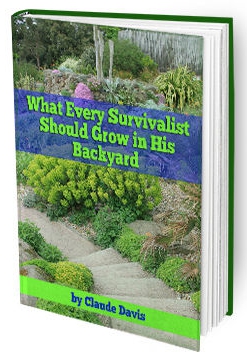With a global pandemic circling the globe and fears of food shortages, many are looking more closely at resurrecting the long-ago practice of having a survival garden.
It is difficult to visualize what our world’s future might look like given the twists and turns of a pandemic. While many are sitting in their homes fearful of what the future may hold, it isn’t difficult to see into my future. I’m planting a garden this year, pandemic or not. But the pandemic does add another layer to gardening and having one could alleviate some of the fears of a food crisis.

We’ve all probably experienced the empty shelves at our local stores. I know I did (the vegetables and organic meats were still available. People wiped out the rice, potatoes, flour, sugar, and junk food though. More importantly, some believe these initial empty store shelves are only the beginning and if this is a long-lasting crisis we could see more breakdowns in stores and social unrest as a result of stores not meeting the demands of the population.
I don’t want to imagine just how fearful people will get, so I have dried and frozen vegetables stocked up along with my husband’s supply of wild game from hunting. And we planted our garden starts already.
The panicked buyers that are emptying shelves have not yet realized there is another, more sustainable option that will provide more food security than hoarding food each time they make a run to the store. They can be in control of their own food supply. You don’t have to worry if you understand how to have a sustainable food supply.
Most Americans firmly believe its impossible to be self-sufficient, and those values are all but permanently engrained into their minds from a young age. Even people who know that organic agriculture is just as productive as industrial agriculture often think you need to have acres and acres of land to grow all of your own food. But that simply is not true. According to the Small Footprint Family, applying certain techniques and principles can get you set on the lifetime journey of potentially being able to grow all your food on as little as a quarter of an acre! Even people in most suburbs could give this a try!
In the past, during troubled times, gardening has always become a fallback to ensure a population could care for themselves. In fact, during World War II, victory gardens became very popular.
Wartime brings real shortages in virtually every area of the economy, especially in the area of foodstuffs. Rationing becomes the norm rather than the exception, and it is difficult for people to scrape out a bare subsistence. During WWII, the Victory garden was recommended by the U.S. Department of Agriculture in a pamphlet published in 1943. The gardens were recommended to have the following vegetables planted:
Spinach, Chard or Kale for greens; Cabbage; Lettuce; Tomatoes; Soy Beans; Snap Beans; Lima Beans; Peas; Asparagus; Carrots; Beets; Turnips; Parsnips; Onions; Strawberries; Raspberries; Radishes; Peppers; Onions; Pole Beans.
That’s quite a list, but it is not comprehensive and many preppers suggest these 25 seeds to start their survival gardens for added nutrition. The point to be made is that if you are able to grow food, then do it during the warm months. Potatoes can be grown inside of old tires, and there are plenty of books and resources out there that will tell you how to perform micro gardening. This is a type of gardening that allows you to maximize the minimal space and arable land that you may have.

Sustainable food production is going to be a vital skill in a long-term emergency
Understanding what to grow, how to do it, and when to grow will put you at a greater advantage for when that time comes. Starting our garden indoors is mandatory due to the short growing season here. In fact, I let the kids help me plant the seeds when they closed the school and we’ve been watching them grow ever since! This is a powerful learning opportunity too, especially if you are locked down and practicing social distancing. Teach your children why we water, and how to water, and you can even lookup images online of the growth stages of certain seeds and vegetables.
HELPFUL HINT: Let your children each choose a few seeds (make sure they will actually grow well in your area) to plant. I did this, and my son is very interested in watching his cucumbers grow. He checks them every morning and tells them goodnight before bed. It’s actually an endearing process to watch, plus he’s learning more about being self-sustainable!
Getting Started
Put thought into how much produce your family will need for the year. This is a great article to start researching. As well, take these eight things into consideration once you’ve decided to start your garden:
- A survival garden should incorporate dependable and easy to grow vegetables that produce more than one harvest or bears more than one fruit per plant.
- The vegetable varieties should be types that the family will eat. It’s not worth the trouble of growing this food if your family will not eat it.
- Grow vegetables that have high amounts of nutrition and vitamins, as well as finding varieties that possess medicinal properties. According to medical experts, green vegetables such as broccoli, Brussel sprouts, Lima beans, peas, asparagus, artichokes, cauliflower, sweet potatoes, and carrots are some of the most nutritious vegetables in the world.
- Find varieties that grow naturally in your area. Environments where plants grow naturally mean that less time and effort will be needed in raising them.
- The need for excessive fertilizing to produce decent-sized produce is a waste of precious resources. There are exceptions to this rule of course; such as if the fertilizer used will help the plant produce many fruits or vegetables.
- If space is limited, plants that take up as little space as possible, but produce abundantly will make for a good investment. Furthermore, finding gardening techniques such as the Three Sisters also makes good use of space.
- Find vegetables that can do well for storage. Vegetables such as potatoes, onions, and root crops like beets and carrots that store well can be used when the weather is too cold to grow.
- Varieties that serve more than one purpose is also an efficient use of space and resources. Varieties such as root crops or broccoli leaves are varieties where the greens can be fed to livestock. In addition, some survivalists agree that yellow dent corn has a multi-purpose use of making grain and feeding livestock. But this crop requires a large amount of land, resources such as fertilizer, and energy to grow this plant to fruition.
When we started our garden, we used these 25 seeds to get started:
All it’s going to take is one or two summers for you to really know what your soil will be able to grow effectively. For example, I love broccoli and we’ve tried it twice, but honestly, I refuse to use pesticides and the natural solutions I’ve found haven’t been able to eliminate the worms we get. We have chosen to avoid growing broccoli outside because of this. But if I do want some, I could always plant some indoors to enjoy!
Other things to consider are encouraging edible weeds to grow. This is difficult for some, as they want to rid their gardens of the ugly plants. But there are some weeds that have lots of nutrition and medicinal properties. For example, dandelions and mullein naturally grow in some areas, and it is easy enough to learn how to use them both for medicinal purposes.
Try these other backyard strategies to achieve food freedom.

source : Sara Tipton



